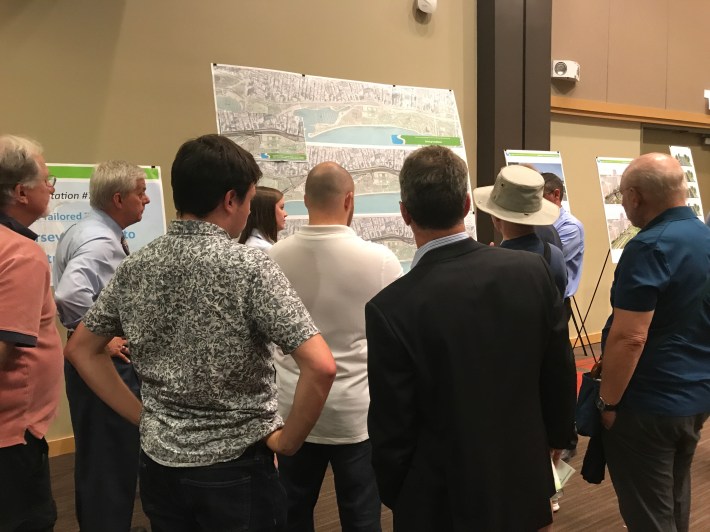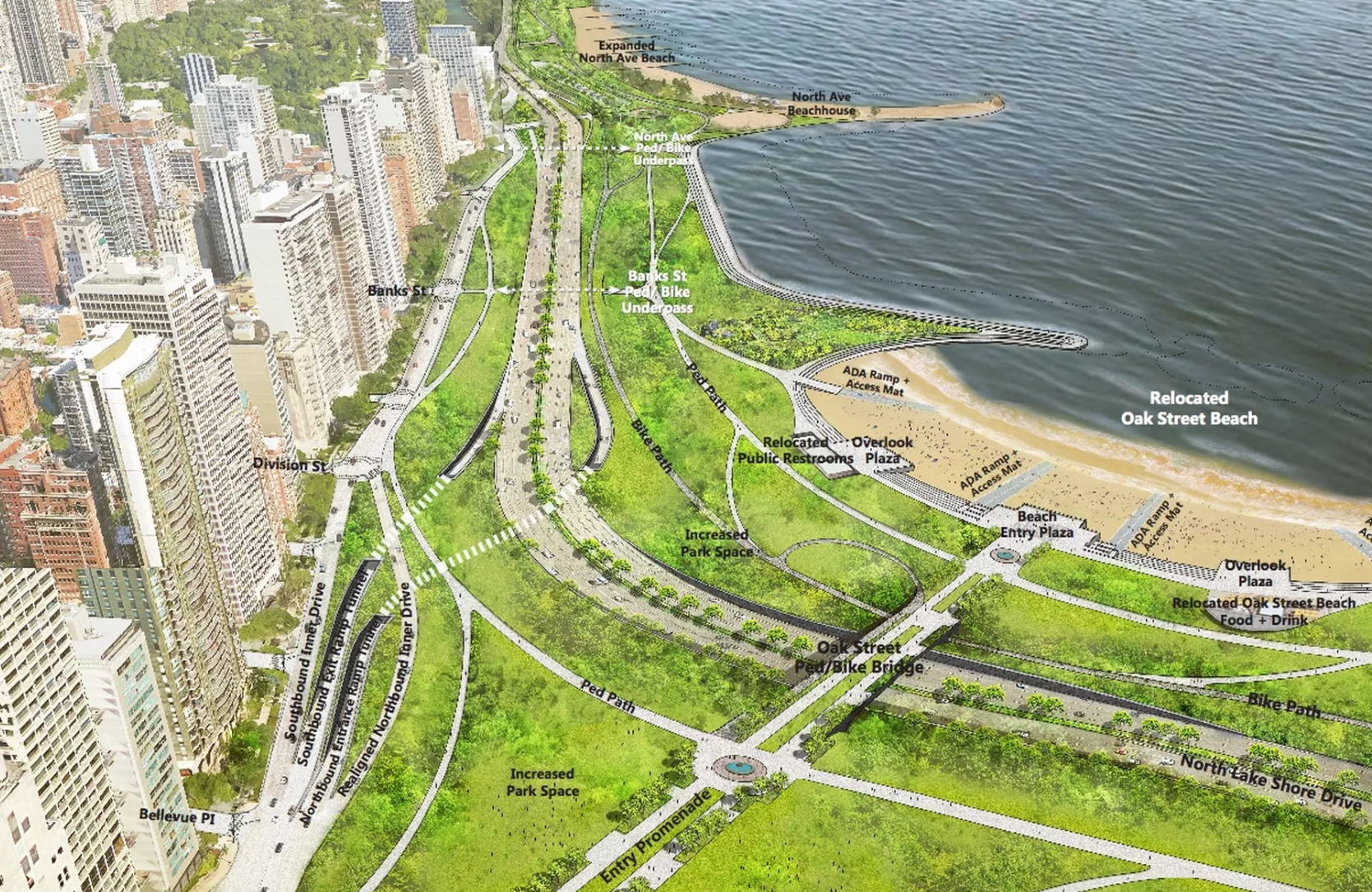At yesterday’s public meeting on the North Lake Shore Drive reconstruction, after well over a year of waiting, the public finally got a better look at what the Illinois and Chicago departments of transportation have planned for the coastal highway. The project has been a long time coming with almost four years of public input and at least another three-to-four years to go before construction starts. During this period, the debate over how the various modes of transportation should be prioritized will continue.
Most of the design alternatives presented at yesterday’s meeting were discussed at the last hearing in May, but earlier this week a few new renderings were released showing proposals to expand the lakefront between Oak Street and North Avenue using infill to create new green space and enlarge the beaches. This scenario would also replace LSD’s at-grade intersection at Chicago Avenue with an underpass and soften the Oak Street S-curve.
There were several computers set up where attendees could take a public survey, in addition to opportunities to write down comments on paper. We were highly encouraged to share the questionnaire with others – you can take it online here. You can also leave comments on the project website.
During the meeting there was significant interest in plans for the convoluted intersection of Belmont and Lake Shore Drive. Many residents wanted a more detailed look at not only how the various options for that junction would affect the neighborhood, but also other alternatives such as the potential for permanent southbound entrance and northbound exit ramps half a mile north at Addison. (Currently there’s a gate at Addison that is opened to allow southbound drivers to exit during Cubs games and other special events.)

There was also a fair amount of confusion over the proposal to split the Fullerton junction by relocating the southbound exit and northbound entrance half a mile north to Diversey. Many residents thought this would dump traffic onto Diversey itself due to the unfortunate placement of the map legend on the rendering, which blocked off a chunk of that area. Instead, the proposal calls for redirecting traffic onto cannon drive and eliminating the existing three-way intersection of Cannon and the Inner Drive. Apparently, the management of the Lincoln Park Zoo, located south of Fullerton, supports this option because they believe splitting the Fullerton junction would make it easier to control large influxes of traffic.
During the meeting there was plenty of feedback indicating that residents from both the the project area and other parts of the city are worried about the North Lake Shore Drive redesign turning the already eight-lane-wide highway into something more like an Interstate. One resident commented that while previous changes to the drive, such as the elimination of the sidewalk on the south side of Fullerton at LSD, made driving more convenient, they significantly contributed to the freeway feel. With public comments in mind, I went to find some residents to talk to.
During the meeting Dietrich Müller, who lives in Streeterville but originally is from Berlin, told me his primary concern is the Chicago Avenue intersection, and so far he likes what he sees from the plans. He says the existing at-grade junction, which forces pedestrians and cyclists to take stairs and a gloomy tunnel to access the lake serves as a barrier to access. Therefore he likes the idea of burying the highway in this location so that “traffic out of sight and out of earshot,” as well as adding additional bike/ped access points. When I asked him what he would do with this location if he were in charge with an unlimited budget, he mentioned Berlin’s Tunnel Tiergarten Spreebogen, a project that buried a highway and covered it with parkland, as a good model for LSD.
On the other hand, Michelle McCarthy told me she was worried that submerging segments of the Drive would make it less pleasant for motorists. She cited Aliotta Haynes & Jeremiah’s song “Lake Shore Drive” and artist Yvonne Jacquette’s painting of the highway as examples of LSD’s cultural significance. McCarthy also had an interesting take on the idea of creating new parkland, saying she was concerned that the additional green space might make it more difficult to find one’s way to the beaches, and that it might create personal security issues. While she doesn’t support adding tolled or managed lanes to the Drive, she is in favor of separating buses and private vehicles via the addition of bus-only lanes.

Ted Ledford told me he’s not happy with how the North Lake Shore Drive planning process is progressing. He sees the project as a fundamentally car-centric one, designed by highway engineers who see improving pedestrian, bike, and transit access as a “cute” afterthought to their main concern of facilitating driving. Ledford added that IDOT needs to do a better job explaining how the proposed treatments would work. He also wants the renderings to show more of the connecting surface roads to better illiterate the potential impacts of the redesign. Ledford also argued that attendees weren’t provided with enough info on how many people are utilizing the lakeside parks and beaches – he felt that it would probably be more appropriate for the Chicago Park District to be leading the redesign process.
CDOT’s Jeff Sriver told me he was very happy with the turnout at the hearing and indicated that, based on interest from the public and aldermen, there may be additional meetings in the near future focusing on proposed changes to specific intersections. He added that the next Task Force meeting would most likely take place this fall or winter with another public meeting in the winter or spring. These will focus more on busway and managed lane treatments as well as more details on the ped/bike enhancements.
This post is made possible by a grant from the Illinois Bicycle Lawyers at Keating Law Offices, P.C., a Chicago, Illinois law firm committed to representing pedestrians and cyclists. The content is Streetsblog Chicago's own, and Keating Law Offices neither endorses the content nor exercises any editorial control.





